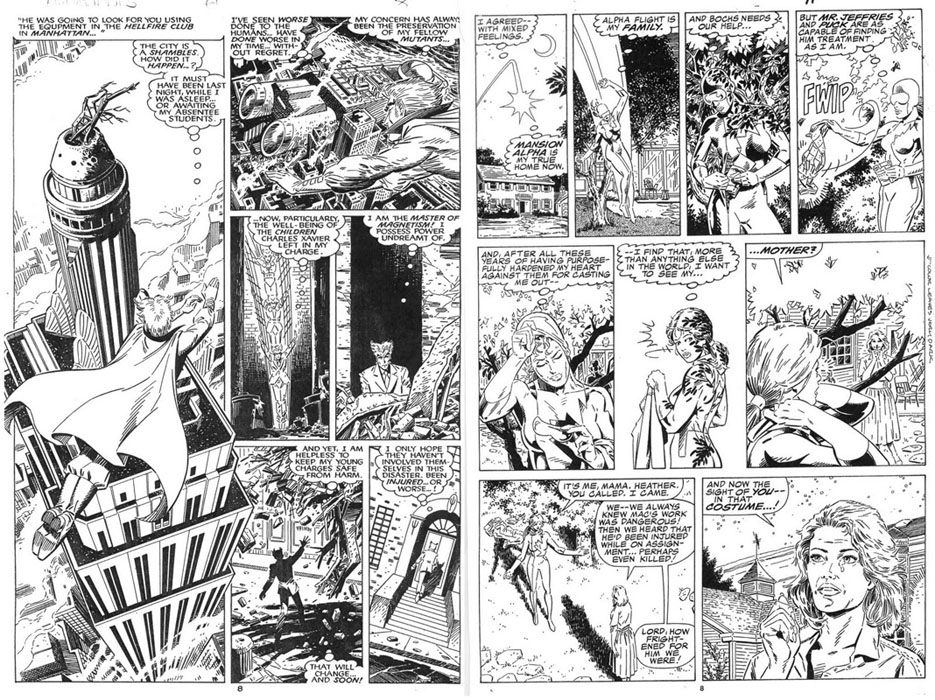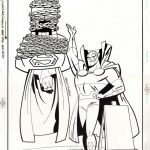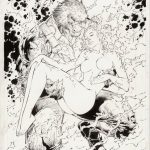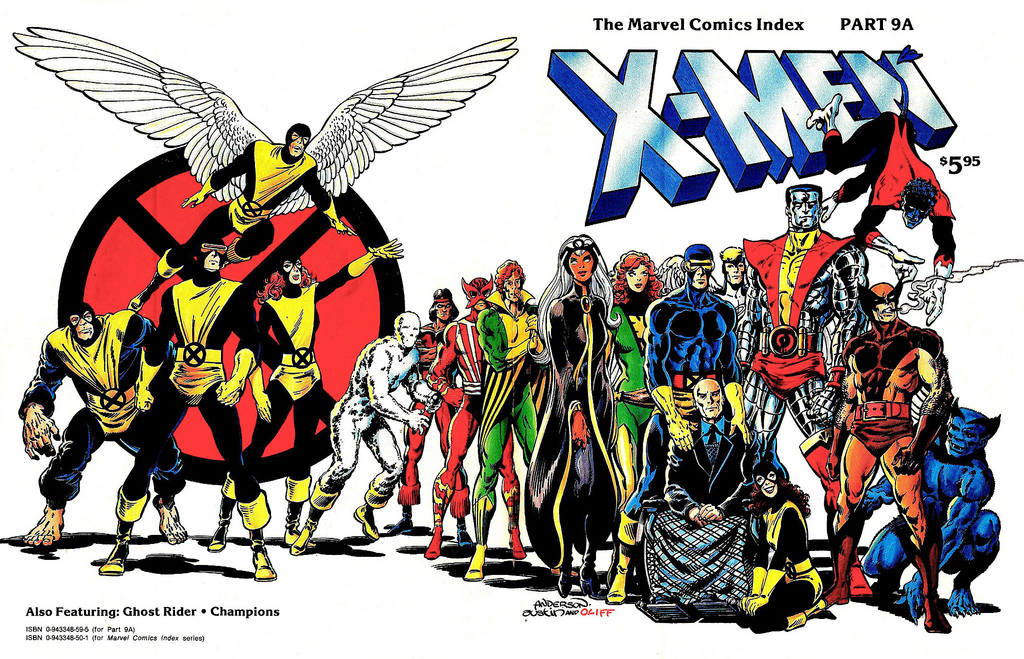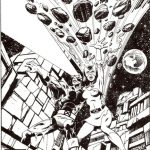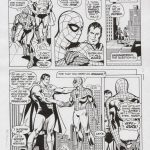There’s a lot that can be said about Terry Austin, but, frankly, most of it has been said before. Terry is generally cited as being a major influence on inkers since the 1980s and there’d surely be a second generation of artists who still look at his work in awe. And rightly so.
It’s somewhat apt that Terry should win the Joe Sinnott Award in the same year as his mentor, Dick Giordano. Terry started out as an assistant to Dick at Continuity Studios and managed to be part of the now legendary Crusty Bunkers, a loose conglomerate of artists who’d ink whatever work was around. To be part of Crusty Bunkers meant that you received on the job training from both your peers and some of the greats and soon to be greats in the comic book industry. A partial list of the Crusty Bunkers reads like a Who’s Who of comic books and includes Neal Adams, Dick Giordano, Bernie Wrightson, Alan Weiss, Alan Kupperberg, Steve Mitchell, Walt Simonson, Jim Starlin, Michael Netzer, Bob McLeod, Bob Wiacek, Marshall Rogers, Joe Rubinstein, Klaus Janson, Carl Potts, Michael Kaluta, Frank Brunner, Dan Green, Howard Chaykin, Gray Morrow and Rich Buckler, just to name a few. The Bunkers worked on material from Marvel, DC, Continuity (of course) and Charlton and, although not credited as such, there is an argument for the Bunkers to be credited with inking parts of the first Superman/Spider-Man cross over, a book that is officially credited to Dick Giordano alone as inker, but featured partial pencils and inks from Neal Adams and backgrounds by Terry, Bob Wiacek and others.
Terry soon outgrew Continuity and being Dick’s assistant and branched out on his own with devastating effects. His first real solo inking work established the groundwork for the career that lay before him as he inked Marshall Rogers on Detective Comics, a run that is still remembered, often reprinted, and seen as being a landmark in comic book illustration for the 1970s. Not since Neal Adams had anyone taken the character of Batman by such storm as Rogers and Austin. Their run with Steve Englehart, albeit shot, was so memorable that twenty years later DC approached the team to reunite and return to the character.
From there Terry could have easily sat back and rested on his laurels. But then, if he’d done that, he’d not be Terry Austin. After reuniting with Rogers for a run on Marvel’s Dr Strange, Terry was assigned to the inker for the Uncanny X-Men. His writer was Chris Claremont, who was just over fourteen issues into one of the longest runs of sustained writing on a single title, and the penciler was what was often referred to as a ‘Young Turk’, fresh from his first major Marvel work on Iron Fist and Marvel Team-Up; John Byrne. The names ‘Byrne and Austin’ have since become synonymous with excellence and their run of nearly forty issues has become the benchmark for all others who have followed. Not since the glory days of Neal Adams and Tom Palmer had the title seen such an art team. Dave Cockrum, a master storyteller and an artist who was a cut above the rest, had laid the groundwork for Byrne and Austin to follow and the duo’s work literally exploded off the page – rarely has there been a more impressive introduction to a new art team than the double page spread that introduced X-Men #108. The team of Claremont, Byrne and Austin (to use the fill title – forget what Marvel’s reprint department would have you believe these days) operated, on the surface at least, virtually seamlessly. Behind the scenes it might have been another matter, but, as David Lee Roth once said to Edward Van Halen, “You don’t have to love me in order to make beautiful music with me.” Byrne might argue the point, but many would strongly suggest that there’s not been a more suitable, or a better inker, for his pencils than Terry Austin.
Seemingly dissatisfied with the direction of the title, Byrne left the X-Men. Marvel wanted to keep Austin, but he decided to leave too, partly because Byrne, who’d been offered the writing and drawing gigs for the Fantastic Four, invited him over. Sadly that didn’t work out, but again, Terry wasn’t one to sit quiet. He joined forces with Paul Smith for another brilliant run on Dr Strange, before heading over to DC Comics to once more make his known little piece of history by reuniting with Byrne for the relaunch of Superman. Moving from there Austin was part of the revamped Justice League, pencilling over Kevin Maguire and showing a lot of young guns how inking is really done by bringing out of the best in Darryl Banks’s pencils on Green Lantern.
If awards are a barometer of ability as opposed to success, then Terry has ability to spare, which is not to say he’s not had his success along the way. Since his magnificent work over Rogers in 1977 he has won seven Eagle Awards for Favourite Inker (including three years in a row), six Comic Buyer’s Guide Fan Award (for Favorite Inker, natch), including four years in a row and an Inkpot Award, all of which will keep his Joe Sinnott Inkwell Award company on the shelf. It was once remarked that Terry’s name, and inks, on a cover would automatically increase the sales of that book by an amount in the tens of thousands back in the day when sales actually counted. There are not many inkers who can have that kind of a claim attributed to them, but Terry does. As an inker he was able to bring out the utmost best in anyone’s pencils, with his precise line work, attention to detail in the backgrounds (always an advantage when working with a penciler who drew foreground images only) and stunning rendering. People today might look at the likes of Tim Townsend and Scott Williams and gasp in awe, but I expect that both Tim and Scott would tell you, freely, that Terry made them gasp, and probably still does.
Terry is often thought to be retired these days but nothing could be further from the truth. Terry is a warm, open guy, always happy to speak and converse, and also ready with a story. Terry is one of the unsung giants of the industry, and as an inker is virtually without peer. It is with the greatest of all pleasures that the Inkwell Award Committee is able to bestow upon the prestigious Joe Sinnott Award, as voted by the people. Take a bow Terry, you’ve earned it.
– Daniel Best
10/01/2010
“When I was first hired on at DC to do finishes back in the mid-70’s, pages for the Superman-Muhammed Ali book were being passed around the office. Sol Harrison came out of his den, sort of looming over things. “See this,” he said, pointing to the backgrounds, “this is what we want buildings to look like, not shoe boxes.” Of course, Terry had done the background buildings. Good 0l’ Terry, always setting a standard the rest of us can’t live up to. He’s still doing it after all these years.” – Joe Staton
“Each new generation of artists stands on the shoulders of the generations who came before. Inevitably, some of these forefathers must bear more weight than others. They create something, a style, an approach, that speaks to the masses and spawns a movement. Through their vision they change the face and direction of an art form for generations to come. In the world of inking, I can count on one hand the number of individuals who can lay claim to this accomplishment.
“Terry Austin is one of the first names to come to mind. He certainly wasn’t the first but, in terms of impact; he was certainly one of the biggest. I grew up on Terry’s work. He brought a technical aspect to his line, a precision that created an entirely new “look” and energy to the pencils he worked with. There was almost a math to it. No matter who the penciler, you could always spot a Terry Austin cover, even from across the comic shop, not only due to the visuals but also the large hole on the magazine rack. Not only has Terry’s work shaped and inspired me; it also shaped and inspired many of the people who trained me. I think, of all inkers, Terry’s work has had more of an impact on me, both directly and indirectly, than any other. Thank you, Terry!” –Tim Townsend 12/22/09
For the first six months or so at Continuity, I shared a room with the late Jack Abel and with Terry Austin. I’ve spoken often about the good spirit and camaraderie in the comics community of that time, much of which was instilled in me within this initial period. If there is anything that can be said about Terry Austin, it would be that as clean as his art always was, so was his heart also.
After having produced several projects for DC, I was offered a three issue arc in Adventure Comics starring Martian Manhunter and some JLA members. Although there was really no connection between J’Onnn J’Onzz and the popular Manhunter series, then produced by the late Archie Goodwin and Walter Simonson for DC, for some reason, I took a cue from the namesake and talked with Terry about applying a Simonson like touch to the art style. Perhaps if only to introduce a little diversity into my work which was very Adams-esque, and mostly inked by the incomparable Joe Rubinstein in those days. Terry thought it would be a good direction and when I suggested his inking would be very suitable for such a style, he responded so favorably that we were able to close the deal with DC within a matter of days.
As the art on that series shows, I really wasn’t able to divorce myself from the Adams influence in the drawing structure and layout. My intention was to embellish it in a way reminiscent of the designed quality of Walt Simonson’s line. And although I may have failed even at that, at least through my own interpretation of it, the result of the pencils was an interesting combination of an Adams like layout and structure, that had a more vibrant, modern and illustrative look than my previous work. It was a big stretch and very disciplined endeavor for me to attain some cohesiveness to the look – and because Terry was more disciplined with inking than penciling, I was somewhat concerned about whether he’d be able to make enough sense of it in order to pull the work together.
To my youthful amazement, Terry Austin not only understood my work and intentions, exactly as I tried to convey, but he also organized and cleaned up the look, far above and beyond any expectations I had. It seemed that he was able to merge his creative approach with mine and succeeded in delivering what is considered as one of the more memorable appearances of The Martian Manhunter in the DC universe to date. Working so closely with Terry over the several months of producing this series revealed that this same quality of understanding other artists and bringing out the best in them, was also Terry’s philosophy on life in his personal relationships. This is what perhaps what makes Terry Austin one of the nicest and most personable creators in the industry, along with the tremendous talent and meticulous dedication to the craft that he’s become known for.
Whenever I look back fondly on the magical days of the ’70s in the NY comics scene, the memory of this project with Terry, and the great times we shared as siblings in the family of comics creators, rise to the surface and leave an indelible sweet flavor in the heart of reminiscences. The comics industry gained a great artist and a wonderful human being the day Terry Austin decided to join it. – Michael Netzer, Jerusalem, 12/3/2009
Terry Austin was the inker for John Byrne’s work on The X-Men in the 1980s, and did his part to help the mutants’ rise to become one of Marvel’s most important features. Besides that, he seems like a helluva nice guy.” — Roy Thomas
“That Austin fella? Always dug his work, and I’ve met him a couple of times, and he’s always been a bud. Because of the incredible volume of work he’s done (and because of its quality), I’d put him right up there with the other top icons of graphic storytelling talents.” – Norm Breyfogle
“Terry burst on to the scene back in the 1970’s with an approach to inking that immediately made him a “must look” artist, one of the few inkers that ever earned that distinction. In my opinion, his work with Rogers on Detective Comics and Byrne on X-Men earned him a place in inking’s Valhalla. The steadiness of his lines, and realistic nature of his backgrounds grounded his characters in their worlds, and the uniqueness of his marks (by his own tools naturally) have given him the distinction of not only making the best out of his penciller’s marks but also indelibly stamping his own look without sacrificing or diluting the penciller’s work. His work has lost none of its sharpness or clarity over the years. His work is simply astonishing to me.” – Charles Yoakum
“I remember Terry Austin on Detective. It altered my thinking on how to approach inking and his style did set the stage for what would take place in the 90s. On The X-Men he showed his true versatility and became a legend.” – Steven Bove
“Long-time friend, Terry Austin, has one of the finest lines in inking. The cubistic quality of his delineations enhances the art of anyone he works with. Some of my own favorite jobs have this man’s name in the credits. Congratulations, Terry. Your body of work rightly deserves all the accolades it might garner.” – Jim Starlin


